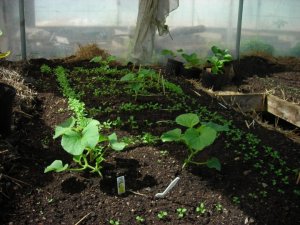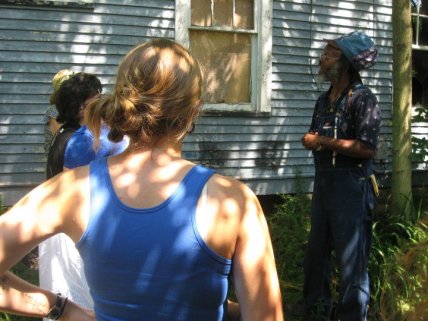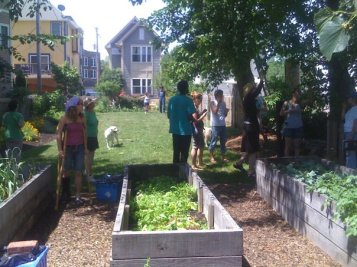Changing Diapers – or the Politics of Urban Agriculture:
the Agrarian Tour through Ohio
In the Ohio chapter of our travels, we – Agrarian Road Trippers – transitioned from the rural to the urban visiting and trading stories with many agrarian minded folks growing goodness in Ohio.
Day Seven:
From the winding roads of West Virginia we traveled to northeast Ohio. We pulled our caravan into a greenhouse nursery and mail-order seed distributor turned church, called Common Ground Church Community located in North Lima, OH. We unpacked our belongings then settled into the sanctuary for an evening of agrarian theology and sing-a-long song sharing.

Three Sisters Garden.
First things first. Greg Bowman, formerly of the Rodale Institute, shared with us what I will call the Theology of the Three Sisters. The Three Sisters growing method (milpa) originated in the Andes and in scattered indigenous communities throughout the Americas. The Three Sisters are corn, beans and squash – related because of their beneficial interactions providing a natural habitat for little critters and a complementary nutrient give-and-take with the soil. Corn provides a trellis for vining beans to climb, as well as protection from the sun for smaller plants and animals. Beans fix nitrogen from the air (complementing the heavy nitrogen-feeder corn). Squash sprawls the ground acting as a living mulch for water retention and weed suppression. Now compare this to a mono-cropped field of corn – exposed soil, neat rows, minimal water retention, nutrient depletion.
How does this all relate to theology? Just like the Three Sisters, we work/live/pray better together than as individual people. The mouth needs a hand to eat, like the corn needs the nitrogen fixed by the beans. As we grow food and appreciate the complex relationship between soil and sun, fruit and flower, a spirit of gratitude is cultivated within us. In our fast-paced, fast food society, we are a people in search of gratification, often lacking in gratitude for the complexity and beauty of life and food.
After a complex discussion about agriculture and theology, we needed a good sing-a-long. Guitars were plucked up from their cases. Congos and djembes pulled out from their nooks and crannies. And so commenced our own versions of “Country Roads” and “Where Have All the Flowers Gone?” Our music leader specialized in James Taylor – so, as you may well be able to tell, our song list was confined to hippie-era music.
Day Eight:
The next morning – a Sunday – we woke to wonderful hospitality and a continental breakfast provided by the folks of Common Ground Church Community, followed by a tour of their partner program, Goodness Grows. Pastor Steve Fortenberry stressed his strong belief in the church as a multi-purpose site, to partner with other community groups and people. Seeing as CGCC is located in an old seed shop and greenhouse, these folks saw it fit to start growing gardens – now expanded to 1-acre in vegetable production. The week of our visit Goodness Grows was starting its own Community Supported Agriculture (CSA) for 15 families. Goodness Grows has only one staff member and a rotating schedule of college interns to maintain the gardens. Volunteers are another main source of labor, coming from the church, as well as a special needs class and GED program in the community. Another special resource for the farm is access to all the horse bedding and manure from the county fair – the largest in the state of Ohio. Future plans include refurbishing the many greenhouses on site for extended season growing as well as aquaculture for heat and fish production, similar to Growing Power in Milwaukee, WI.
After worship, we had another round table discussion with Pastor Steve, politically-connected Greg Harget from OH Governor Ted Strickland’s office, and prophetic farmer Maurice Small. Greg Harget Ohio Department of Agriculture but now works with Governor Strickland’s Faith-based and Community Initiatives Program in Ohio, which facilitates the state’s summer feeding programs as well as re-entry programs to strengthen the family. Maurice Small, on the other hand, works outside of the conventional systems of institutional agriculture and government. Maurice Small started a Cleveland-based organization called City Fresh, expanding access to food through urban agriculture. Because of the success of City Fresh in Cleveland, Maurice was invited to Youngstown, OH to help invigorate new growing initiatives.
Itching to get outside, Maurice sped up our conversation and we caravan-ed into Youngstown. We jump out of the van and are greeted with Maurice’s first question: “What is the murder rate of the place you live? This is important. You don’t know it, you don’t know your people.”
Maurice - telling it like it is.
Background on Youngstown: Former steel town. 80,000 people. 20,000 vacant lots. Worst school system in Ohio. Enter Maurice Small, urban gardening pioneer. Maurice’s mission is to reclaim vacant lots – lots where abandoned houses have been torn down or are still standing – and using reclaimed windows and boards from those houses and buildings, build raised garden beds. The first block Maurice walks us through has 10 houses – only two of which have residents. This is a ghost town. Maurice shows us the foundation of a house, crumbling and exposed – left vacant for 20-some years. Beyond repair. “They left [this city, these houses] . . . to my imagination.” Let me repeat that one more time: “They left this city . . . to my imagination.” Awesome.
And his imagination envisions life and food, bountiful as the Garden of Eden. In addition to using reclaimed materials, Maurice builds raised beds from straw bales, with composted horse manure as his soil The straw bales are great for two reasons: 1. As the straw bales break down, they become organic matter to enrich the soil, and 2. Straw bales provide a sitting area directly in the garden. Maurice purchases the bales from a local farmer for $2.75, has horse manure donated from the county fair, and receives woodchip mulch and water from the city for free. He plants perennials and fruit trees and envisions the neighborhood children grabbing an apple on the way to school. He envisions neighborhood farm markets on garden property, where eater and grower get to know one another.
Straw bale beds - with composted horse manure soil.
Besides building gardens, Maurice is all about building community. While Maurice’s visions are beautiful and inviting, he is adamant that people do not flock to the places romanticized for their poverty or their potential. No gentrification. White people stay out. Help where you are from. This must be an indigenous revolution. The community must do for themselves. Then integrate slowly. Although Maurice is from Cleveland, he has been invited into Youngstown to help. Maurice has $400,000 over the next three years to jump start the gardens. He hopes to be out as soon as possible and let neighbors take the initiative to keep growing. Pointing to his toddling son, “I’m just here to change their diapers – then get out. Set ‘em on their way.”
With heads still whirling from the wisdom of prophet and poet Maurice, we jumped in the vans and headed towards Cleveland to dine with and tour the gardens of some folks involved in an entrepreneurial market garden program in and around Cleveland’s EcoVillage.
Market Gardens in Cleveland's Eco-Village.
Day Nine:
After a much needed deep sleep, we took to the road again to explore the urban agriculture scene in Cleveland – as led by Maurice. We Road Trippers continually made comments about Maurice’s incredible ability to identify every pocket garden and food project around the city – indicating some extremely detailed mental map of urban agriculture craziness inside his head.
Our first stop, Gather Round Garden. Planted on top of a parking lot of an old convenience/liquor store transformed into a childcare center. Lots of amoeba-shaped raised garden beds in every shape and form. Bantam chickens and roosters cluck out of their coop refashioned from old windows and boards. Food goes to a store-front shelter and soup kitchen organized by a Catholic Worker House – as well as being distributed throughout the neighborhood. Worked out a lease with the landowner for $1. Been growing for 4 ½ years.
Second stop: the Kentucky Gardens. Been around for over 50 years. Less than one acre. 200 families. Community greenhouse. Plots are rented out by the summer growing season – $10/large bed, $5/small plot. Each gardener is required to contribute so many hours of service to the maintenance and upkeep of the property each year. Has a fruit orchard and beehives. Here we met Maurice’s mother.
Third stop(s): two chefs. Chef one – growing in an alleyway betwixt two very large buildings. Marigold Catering. Herbs, edible flowers, vegetables, and mushroom logs. Chef Two – Chef Karen Small of the Flying Fig. With the help of youth recruited and trained by Maurice, built raised beds in her backyard. Grows herbs, vegetables, and watercress (in a simple outdoor aquaculture system) for use in her restaurant based around local foods. Here our fingers – and lips – became stained with the purple blood of mulberries, as we avidly harvested backyard berries at Karen’s invitation.
Fourth stop: Vel’s Purple Oasis. Started in 2008 by a grandmother and her granddaughter Kayla. Bought land 20 years ago with the dream of someday having a garden. Named after Vel’s love of the color purple – which represents majestic royalty. The garden is an oasis in the midst of Cleveland’s death and drought. Rebuilding the soil by solarizing the weeds, laying down cardboard and sickle-cutting hay to build lasagna garden beds. Built a strawbale greenhouse with the help of Brad Massey at the New Agrarian Center in Oberlin. Recently bought some nearby house to open as a community kitchen and place of holistic healing.
We were unable to visit the New Agrarian Center in Oberlin, OH, due to the craziness of our schedule and the wealth of information already clogging our noggins. So we went to the West Side Market (Cleveland’s year-round indoor market) or falafels. That evening we enjoy a sunset – and the Summer Solstice – on Lake Erie.
My closing thoughts:
“To everything, there is a season, and a time to every purpose under the heaven: a time to be born and a time to die, a time to plant and a time to pluck up that which is planted, a time to kill and a time to be healed.”
- Ecclesiastes 3:1-3
End Day Nine. End Part Four.













No comments:
Post a Comment